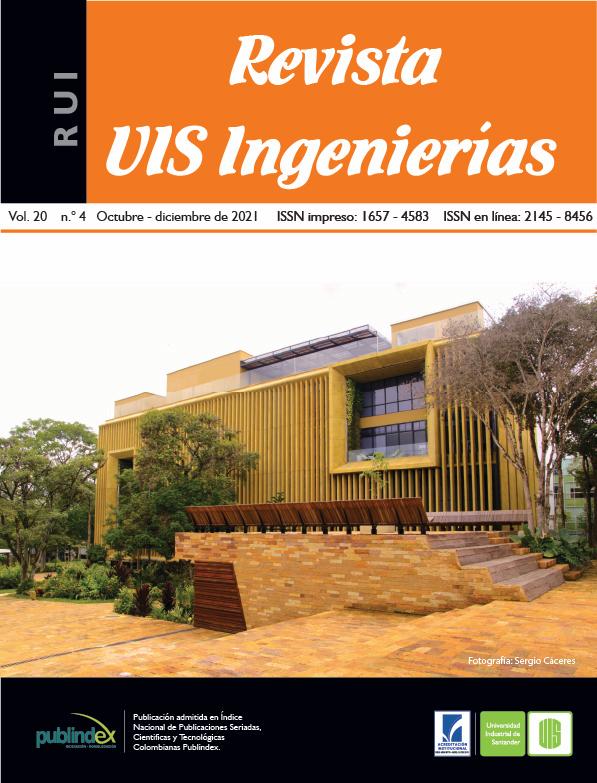A Multitemporal and statistical analysis of physicochemical parameters monitored in the upper basin of the Bogotá River
Published 2021-07-07
Keywords
- Agreement 43 of 2006,
- basin,
- Bogotá River,
- CAR,
- environmental parameters
- flows,
- limit,
- multitemporal analysis,
- statistical,
- water quality ...More
How to Cite
Copyright (c) 2021 Revista UIS Ingenierías

This work is licensed under a Creative Commons Attribution-NoDerivatives 4.0 International License.
Abstract
Anthropic activities have progressively left their mark in the environment where man benefits from the ecosystem goods and services, which has transcended socio-environmental conflicts throughout history. Proof of this is the drastic changes suffered by the Bogotá River due to the uncontrolled discharges from the continuous growth of populations and activities surrounding the body of water. In the present study, the variability of the environmental parameters in the upper basin of the Bogotá River between the years 2007 to 2019 is exposed after the issuance of the Agreement 43 of 2006 of the CAR, for which a multi-temporal analysis was carried out and statistical data. The results show that throughout the twelve (12) years of monitoring there is no contamination due to nitrates, nitrites, or sulfates in the upper basin of the Bogotá River, similarly, the monitored pH remained within the objectives of quality except for 3 years in which the maximum value allowed in the upper part of the basin was exceeded. However, the increasing deterioration of the water quality in the Bogotá River is mainly attributed to the total suspended solids that shows a permanent non-compliance in the upper and lower upper basin, added to the non-compliance in the lower upper basin according to the quality objectives for the dissolved oxygen, BOD and COD parameters. Consequently, the results show the scarce impact derived from the actions developed by the local and environmental authorities to ensure the quality objectives in the upper basin of the Bogotá River, and the effect of weak water governance in the basin.
Downloads
References
[2] I. Barajas, J. Mahlknecht, J. Kaledin, M. Kjellén, A. Mejía, Aguas y ciudades en América Latina: Retos para el desarrollo sostenible. Inter-American Development Bank, 2018
[3] Corporación Autónoma Regional de Cundinamarca – CAR, “Vive el Río Bogotá”, S.F. [En Línea]. Disponible en: https://www.car.gov.co/rio_bogota/vercontenido/5#:~:text=Los%20vertimientos%20industriales%20de%20las,el%2080%25%20de%20la%20contaminaci%C3%B3n.
[4] Corporación Autónoma Regional de Cundinamarca – CAR, “Evaluación Regional del Agua - ERA Cuenca Alta del río Bogotá”, S.F. [En línea]. Disponible en: http://www.andi.com.co/Uploads/ERA%20CUENCA%20ALTA%20R%C3%8DO%20BOGOT%C3%81.pdf.
[5] Secretaría Distrital de Planeación, “Aproximación a las implicaciones del Fallo del Consejo de Estado sobre el Río Bogotá”, 2014. [En línea]. Disponible en: http://www.sdp.gov.co/sites/default/files/aproximacion_a_las_implicaciones_del_fallo_del_consejo_de_estado_sobre_el_rio_bogota.pdf.
[6] A. Rodríguez, J. González, R. Suárez, “Bioacumulación por metales pesados en el capitán de la Sabana (Eremophilus mutisii), habitante de la cuenca alta del río Bogotá”, Revista electrónica de Ingeniería en Producción Acuícola, vol. 3, no. 3, 2007.
[7] A. Sanabria, C. Montenegro, M. Castro, D. Díaz, “Análisis multitemporal del índice de calidad del agua (WQI) en corrientes superficiales en la cuenca alta del río Bogotá”, Ingeniería Solidaria, vol. 13, no. 2, pp. 39-54, 2017, doi: 10.16925/in.v13i22.1751.
[8] Por el cual se establecen los objetivos de calidad del agua para la cuenca del río Bogotá a lograr en el año 2020, Acuerdo 43, 2006. [En línea]. Disponible en: https://www.alcaldiabogota.gov.co/sisjur/normas/Norma1.jsp?i=22067.
[9] E. Chuvieco, Fundamentos de Teledetección Espacial, 2 ed. Madrid: Ediciones RIALP S.A, 1995.
[10] M. J. Jiménez-Moreno, M. J. González-Guillén, M. Escalona-Maurice, J. R. Valdez-Lazalde, C. A. Aguirre-Salado “Comparación de métodos espaciales para detectar cambios en el uso del suelo urbano”, Revista Chapingo serie ciencias forestales y del ambiente, vol. 17, no. 3, pp. 389-406, 2011.
[11] Decreto Único Reglamentario del Sector Ambiente y Desarrollo Sostenible, Decreto 1076, 2015. [En línea]. Disponible en: www.parquesnacionales.gov.co/portal/wp-content/uploads/2013/08/Decreto-Unico-Reglamentario-Sector-Ambiental-1076-Mayo-2015.pdf.
[12] “Modelación dinámica de la calidad del agua del río Bogotá”, EAAB-Universidad Nacional de Colombia, Informe Producto No. 2, 2009.
[13] J. Díaz, C. Granada, “Efecto de las actividades antrópicas sobre las características fisicoquímicas y microbiológicas del río Bogotá a lo largo del municipio de Villapinzón”, Revista de la facultad de medicina, vol. 66, no. 1, pp. 45-52, 2016, doi: 10.15446/revfacmed.v66n1.59728.
[14] Gobernación de Cundinamarca – Secretaría de Ambiente y Universidad de La Salle, “Estrategias de producción más limpia en la cuenca alta del Río Bogotá”, 2016. [En línea]. Disponible en: www.orarbo.gov.co/es/el-observatorio-y-los-municipios/estrategias-de-produccion-mas-limpia-en-la-cuenca-alta-del-rio-bogota.
[15] D. Aguirre, “Actualización de los Escenarios de Saneamiento del río Bogotá”, trabajo de grado, Universidad de los Andes, Bogotá, 2015
[16] Corporación Autónoma Regional de Cundinamarca – CAR, “Río Bogotá: Adecuación hidráulica y recuperación ambiental”, Evaluación Ambiental y Plan de Gestión Ambiental, vol. 1, no. 11-30, pp. 1-157, 2020.
[17] A. F. Suárez, C. A. García, M. L. Vaca, “Identificación y evaluación de la contaminación del agua por curtiembres en el municipio de Villapinzón”, Tecnura, vol. 16, pp. 185-193, 2012.
[18] C. Sierra, Calidad del agua: evaluación y diagnóstico. Medellín: Editorial de la Universidad de Medellín, 2011.
[19] C. N. Sawyer, P. L. McCarty, y G.F. Parkin, Química para la ingeniería ambiental, 4 ed. Bogotá: McGraw-Hill, 2000.
[20] E. González-Pérez, H. M. Ortega-Escobar, M. J. Yáñez-Morales, A. Rodríguez-Guillen, “Diagnóstico de indicadores de calidad fisicoquímica del agua en afluentes del río Atoyac”, Tecnología y Ciencias Del Agua, vol. 10, no. 1, pp. 1-28, 2019, doi: 310.24850/j-tyca-2019-01-02

